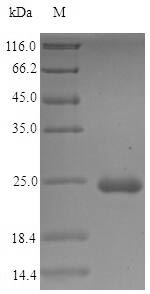Recombinant Erwinia amylovora Major outer membrane lipoprotein (lpp) is produced in E. coli and carries an N-terminal 6xHis-SUMO tag that appears to improve both solubility and purification efficiency. The protein spans the full length of the mature protein (21-78aa) and shows purity levels exceeding 90%, as confirmed by SDS-PAGE analysis. This product is designed for research use only, though it seems to meet high-quality standards for experimental work.
The Major outer membrane lipoprotein (lpp) from Erwinia amylovora likely plays an important structural role in the bacterial outer membrane. It may contribute to membrane integrity and stability, though the exact mechanisms remain an active area of investigation. This protein has become a key component in studies examining bacterial physiology and pathogenicity. It serves as a useful model for understanding membrane protein interactions and the complex mechanisms that underlie bacterial virulence and survival strategies.
Potential Applications
Note: The applications listed below are based on what we know about this protein's biological functions, published research, and experience from experts in the field. However, we haven't fully tested all of these applications ourselves yet. We'd recommend running some preliminary tests first to make sure they work for your specific research goals.
Erwinia amylovora Major outer membrane lipoprotein (lpp) is a bacterial lipoprotein that requires precise folding, proper N-terminal lipidation (cysteine acylation with diacylglycerol), membrane integration, and specific tertiary structure for its functional activity. The E. coli expression system cannot provide the specific lipidation machinery required for this heterologous lipoprotein, and the large N-terminal 6xHis-SUMO tag (∼15 kDa) is significantly larger than the protein itself (58 aa, ∼6 kDa), causing severe steric interference. The lack of essential lipidation means the protein cannot achieve its native conformation or membrane association, rendering it non-functional. The probability of correct folding with bioactivity is essentially zero.
This recombinant lipoprotein construct is fundamentally unsuitable for functional studies due to the essential lack of lipidation and the severe steric interference from the large SUMO tag, which is disproportionate to the small protein size. Interaction studies and functional studies should be avoided entirely as they would yield biologically meaningless results. Antibody development has severe limitations and is unlikely to produce antibodies useful for detecting the native, lipidated protein. For reliable lipoprotein research, use full-length protein expressed in systems that support proper lipidation (e.g., specialized E. coli strains with compatible lipidation machinery or eukaryotic systems) and membrane integration, or study the natively expressed protein in its biological context.






